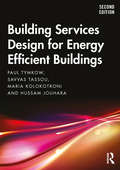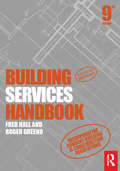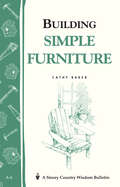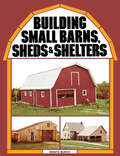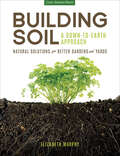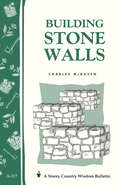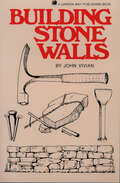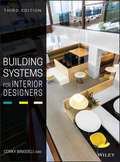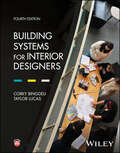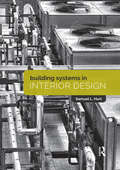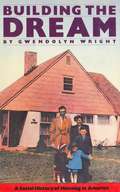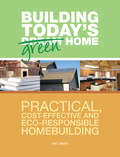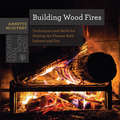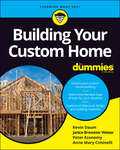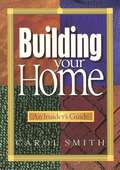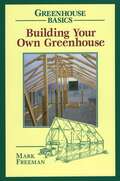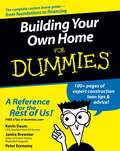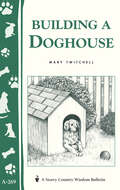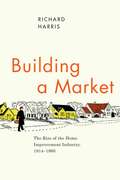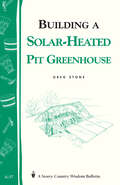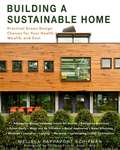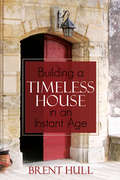- Table View
- List View
Building Rural Community Resilience Through Innovation and Entrepreneurship (ISSN)
by Charlie FrenchDrawing from empirical analyses, case studies, and a synthesis of best practices, this book explores how innovation manifests itself in rural places and how it contributes to entrepreneurial development and resilience. Innovation in rural places may come about as a result of new forms of collaboration; policies that leverage rural assets and address critical service or product gaps; novel strategies for accessing financial capital; infusion of arts into aspects of community life; and cultivation of networks that bridge entrepreneurs, organizations, and institutions. The chapters illustrate how a number of innovation-related characteristics relate to economic vibrancy in rural places such as a strong connection to the arts, adaptive and sustainable use of natural resources, value-chain integrated food systems, robust bridging social capital networks, creative leveraging of technology, and presence of innovation-focused entrepreneurs. Through exploration of these and other topics, this book will provide insights and best practices for rural community and economic development scholars and practitioners seeking to strengthen the rural innovation ecosystem.
Building Services Design for Energy Efficient Buildings
by Paul Tymkow Savvas Tassou Maria Kolokotroni Hussam JouharaThe role and influence of building services engineers are undergoing rapid change and are pivotal to achieving low-carbon buildings. However, textbooks in the field have tended to remain fairly traditional with a detailed focus on the technicalities of heating, ventilation and air-conditioning (HVAC) systems, often with little wider context. This book addresses that need by embracing a contemporary understanding of the challenge to address climate change, together with practical approaches to energy efficiency and carbon mitigation for mechanical and electrical systems, in a concise manner. The essential conceptual design issues for planning the principal building services systems that influence energy efficiency are examined in detail. These are HVAC and electrical systems. In addition, the following issues are addressed: background issues on climate change, whole-life performance and design collaboration generic strategies for energy efficient, low-carbon design health & wellbeing and post-occupancy evaluation building ventilation air-conditioning and HVAC system selection thermal energy generation and distribution systems low-energy approaches for thermal control electrical systems, data collection, controls and monitoring building thermal load assessment building electric power load assessment space planning and design integration with other disciplines. In order to deliver buildings that help to mitigate climate change impacts, a new perspective is required for building services engineers, from the initial conceptual design and throughout the design collaboration with other disciplines. This book provides a contemporary introduction and guide to this new approach, for students and practitioners alike.
Building Services Handbook
by Roger Greeno Fred HallThe ninth edition of Hall and Greeno's leading textbook has been reviewed and updated in relation to the latest building and water regulations, new technology, and new legislation. For this edition, new updates includes: the reappraisal of CO2 emissions targets, updates to sections on ventilation, fuel, A/C, refrigeration, water supply, electricity and power supply, sprinkler systems, and much more. Building Services Handbook summarises the application of all common elements of building services practice, technique and procedure, to provide an essential information resource for students as well as practitioners working in building services, building management and the facilities administration and maintenance sectors of the construction industry. Information is presented in the highly illustrated and accessible style of the best-selling companion title Building Construction Handbook. THE comprehensive reference for all construction and building services students, Building Services Handbook is ideal for a wide range of courses including NVQ and BTEC National through Higher National Certificate and Diploma to Foundation and three-year Degree level. The clear illustrations and complementary references to industry Standards combine essential guidance with a resource base for further reading and development of specific topics.
Building Simple Furniture: Storey Country Wisdom Bulletin A-06 (Storey Country Wisdom Bulletin Ser.)
by Cathy BakerEASY-TO-BUILD PROJECTS FOR THE WEEKEND WOODWORKER! <P><P>Look over the variety of simple wood-working projects in the bulletin and you’ll quickly find something that deserves a place in your home. A small table for the hallway, perhaps, or an Adirondack chair or picnic set for the deck or garden? <P><P>The good news is that you don’t need to be a master carpenter with a basement full of power tools to craft these handsome and practical items. With a few simple hand tools and Cathy Baker’s step-by-step instructions and easy-to-follow illustrations and diagrams, you can build sturdy, durable, beautiful wooden furniture that you and your family will enjoy for years to come. <P><P>Projects include:· <br> Wall shelf· <br> Small bench· <br> Picnic table and benches· <br> Adirondack chair· <br> Pump lamp· <br> Step stool· <br> Storage box· <br> Side table
Building Small Barns, Sheds & Shelters
by Monte BurchBuild your own outbuildings and enjoy the space to do more of what you love. From simple toolsheds and animal shelters to smokehouses and low-cost barns, Monte Burch guides you through everything you need to know to make your small building projects a reality. Detailed blueprints, easy-to-follow instructions, and expert advice are suited to even the first-time builder. Discover how easy it is to create your own customized spaces that will allow your passions to grow.
Building Soil: Natural Solutions for Better Gardens and Yards
by Elizabeth MurphyA down-to-earth, complete manual for achieving great gardening results with your own rich, organic soil.All the secrets to rich, sustainable soil are revealed to you. You’ll be amazed how easy it is to improve your garden or yard when you begin at ground level.Even experienced gardeners can be intimidated by soil. It isn’t just the soil-testing data and all the big words, like vermicompositing and mycorrhizal fungi. It’s also the fact that when you begin to work with the soil, you’re working with the very earth you grow in; you don’t want to make any mistakes. But with Building Soil as your guide, you can achieve your goal of rich, sustainable soil without the fear.Building Soil: A Down-to-Earth Approach is rich with practical, up-to-date information on how to grow and maintain healthy soils. Simple methods perfect for the home gardener’s use put healthy, organic soil within everyone’s reach. Because it’s written in plain language, you don’t need a degree in soil management to understand this book—you only need a yard or garden and the desire to improve it at the most basic level. By following author Elizabeth Murphy’s detailed instructions, you can become a successful soil-based gardener, whether you want to start a garden from scratch or improve an existing plot.Less weeding & laborLess water waste100% natural
Building Stone Walls: Storey's Country Wisdom Bulletin A-217
by Charles McRavenSince 1973, Storey's Country Wisdom Bulletins have offered practical, hands-on instructions designed to help readers master dozens of country living skills quickly and easily. There are now more than 170 titles in this series, and their remarkable popularity reflects the common desire of country and city dwellers alike to cultivate personal independence in everyday life.
Building Stone Walls: Storey's Country Wisdom Bulletin A-217
by John VivianRustic and charming or stately and proud, a well-built stone wall can add personality and beauty to your property. John Vivian’s lively approach and step-by-step instructions encourage you to transform a pile of rocks into an enduring landscape feature with gates, retaining walls, or stiles to suit your needs. Whatever unique challenges come with your site — poor drainage, sloping ground, or low-quality rubble material — Vivian offers innovative designs and reproducible methods to help you build a beautiful, long-lasting wall.
Building Systems for Interior Designers
by Corky BinggeliBuilding Systems for interior designersSecond EditionCorky Binggeli, asidThe updated guide to technical building systems for interior designersAs integral members of the building design team, interior designers share an increasingly complex and crucial role. Now revised in its second edition, Building Systems for Interior Designers remains the one go-to resource that addresses the special concerns of the interior designer within the broader context of the rest of the building design team. Building Systems for Interior Designers, Second Edition explains technical building systems and engineering issues in a clear and accessible way to interior designers. Covering systems from HVAC to water and waste to lighting, transportation, and safety, author Corky Binggeli enables interior designers to communicate more effectively with architects, engineers, and contractors; collaborate effectively on projects; and contribute to more accurate solutions for a broad range of building considerations.Among the many improvements in the Second Edition are: A deeper engagement with sustainable building design, giving the interior designer the resources needed to participate as part of a sustainable design team A reshaped structure that enhances the reader's understanding of the material Many more illustrations and explanatory captionsWith a host of features to make the book more up to date, easier to use, and more effective as an instructive guide, Building Systems for Interior Designers, Second Edition is a valuable book for students as well as a practical desktop reference for professionals.
Building Systems for Interior Designers
by Corky Binggeli Taylor LucasBUILDING SYSTEMS FOR INTERIOR DESIGNERS Make design decisions informed by technical and structural knowledge with this essential guide Professional interior design demands more than simply an understanding of aesthetic and artistic considerations; it also requires a detailed understanding of building systems and their interactions. Design decisions must account for mechanical and electrical equipment, building components, and structural elements, all of which can potentially shape a designer’s work. Building Systems for Interior Designers has long stood as the key to understanding and evaluating these elements, particularly key building systems like HVAC and plumbing, and their impacts on interior design. This Fourth Edition is fully updated to fit the needs of the CIDA certified interior design program and the NCIDQ exam. The fourth edition of Building Systems for Interior Designers also includes: Updated information on sustainable and energy-efficient design Detailed coverage of topics including security concerns, fire safety, and designing secure spaces Classroom supplements including sample construction documents, chapter specific discussion questions, and more Building Systems for Interior Designers is ideal for students in interior design courses and new professionals studying for NCIDQ exams.
Building Systems in Interior Design
by Samuel L. Hurt<p>Building Systems in Interior Design takes an entirely new approach to teaching this essential topic for Architects, Designers and Building Engineers. Written to prepare students for the real world and packed with practical examples, the book will foster an understanding of specific issues that are critical to those features of technical systems that most directly affect design. The book stresses the ever-present nature of these systems: they are everywhere, all the time. <p>Taking a design oriented view, it outlines what can and cannot be done, and provides the student with the know-how and confidence to defend and promote their design intent when working with other industry professionals. <p>Covering lighting, HVAC, plumbing and much more, the book is packed with key features to aid learning including: <p> <li>Numerous illustrations, plans and photographs <li>Key terms defined in an extensive glossary <li>Chapter introductions that identify key concepts and chapter summaries to re-visit those key concepts <li>Professional design tips <li>And a detailed bibliography and web links</li> <p> <p>This book is not only a core text for interior design, building systems engineering and architecture students but will become an essential working reference through their careers.</p>
Building The Dream
by Gwendolyn WrightFor Gwendolyn Wright, the houses of America are the diaries of the American people. They create a fascinating chronicle of the way we have lived, and a reflection of every political, economic, or social issue we have been concerned with. Why did plantation owners build uniform cabins for their slaves? Why were all the walls in nineteenth-century tenements painted white? Why did the parlor suddenly disappear from middle-class houses at the turn of the century? How did the federal highway system change the way millions of Americans raised their families?Building the Dream introduces the parade of people, policies, and ideologies that have shaped the course of our daily lives by shaping the rooms we have grown up in. In the row houses of colonial Philadelphia, the luxury apartments of New York City, the prefab houses of Levittown, and the public-housing towers of Chicago, Wright discovers revealing clues to our past and a new way of looking at such contemporary issues as integration, sustainable energy, the needs of the elderly, and how we define "family."
Building Today's Green Home: Practical, Cost-Effective and Eco-Responsible Homebuilding
by Art SmithMake Your Green Home a Reality! Building the right-sized green home involves making eco-smart decisions. In Building Today's Green Home, you will learn: How to choose the correct location of your building lot and what is the optimum placement of your house to take advantage of solar energy How to design the right-sized home for your needs now and in the future What are the best sustainable construction materials to use for building your home About the newest insulation materials and techniques What HVAC units are the most efficient and are the best at saving energy How to grade the building lot for natural sustainability The decisions you make today will have a huge impact on your future and the future of your children. And, building the right-sized energy-efficient home will free up investment capital for your retirement years.
Building Wealth Buying Foreclosures
by John W. Schaub<p>Foreclosures are one of the biggest real estate investment opportunities available in today's market. They also have a compelling benefit--when you buy a property on the brink of foreclosure, you're solving that problem for the previous owner, and getting a great deal in the process. <i>Building Wealth Buying Foreclosures</i> helps you target top properties and get the best deal, with tips on how to avoid scams, insight into the lender's perspective, and a checklist that helps you keep track of every step of the way. <p>Inside information on how to: <p> <li>Target only the right properties to buy <li>Negotiate the best price <li>Get a good deal on a mortgage <li>Make the right offer at the right time <li>Understand the lender's perspective <li>Make sense of title insurance <li>Decide to rent or sell the property</li> </p>
Building Wood Fires: Techniques And Skills For Stoking The Flames Both Indoors And Out (Countryman Know How #0)
by Annette McGivneyLearn everything there is to know about building a wood fire. Fire has brought humans together for millennia. The cozy warmth of the hearth and the adventure of the campfire draw the same attention today as they did 100 years ago. Part how-to, part history of fire, Building Wood Fires is an essential guide for anyone with a fireplace, backyard fire pit, or love of camping. Outdoor journalist and wilderness expert Annette McGivney shares years of expertise, providing tips from whereto build your fire pit to how to roast the perfect marshmallow and helpful diagrams to demonstrate essential techniques.
Building Your Custom Home For Dummies
by Peter Economy Kevin Daum Janice Brewster Anne Mary CiminelliBuild a place you’ll love to come home to Why settle for a house that looks like every other one in the neighborhood? With Building Your Custom Home For Dummies on your desk (right alongside those inspiring architecture magazines), you can design and build the home of your dreams. From brainstorming must-have features to hanging a wreath on the front door, this book walks you through what you need to know from start to finish. Get savvy on purchasing property, securing financing, and raising the walls that will become the setting for life’s next chapter. If you can imagine it, you can build it! Inside… Locate your ideal building site Hire an architecture and contracting team you can trust Finance smoothly and manage your construction budget Discover new green building techniques Oversee construction from A to Z Furnish, landscape, and maintain your property
Building Your Home: An Insider's Guide
by Carol SmithIn the second edition of Building Your Home: An Insider's Guide, customer service expert Carol Smith shows you how to work with your builder to create the home of your dreams. This guide is a must-have for anyone planning to build a high-quality home. With this comprehensive, step-by-step book, you can avoid common mistakes in the home building process and choose a qualified builder, establish your budget and secure financing, select the location, benefits, and features of your new home, participate effectively in the design and building process, prepare for home owner orientation, closing, and moving in, create a home maintenance plan, communicate with your builder on warranty service.
Building Your Own Greenhouse
by Mark FreemanThe fundamentals of assembling a greenhouse and customizing it to the gardener's needs.
Building Your Own Home For Dummies
by Peter Economy Kevin Daum Janice BrewsterKeep construction on track with helpful checklists Turn your dream of a custom home into reality! Thinking about building your own home? This easy-to-follow guide shows you how to plan and build a beautiful home on any budget. From acquiring land to finding the best architect to overseeing the construction, you get lots of savvy tips on managing your new investment wisely -- and staying sane during the process! Discover how to: * Find the best homesite * Navigate the plan approval process * Obtain financing * Hire the right contractor * Cut design and construction costs * Avoid common mistakes
Building Your Permaculture Property: A Five-Step Process to Design and Develop Land (Mother Earth News Wiser Living Ser.)
by Rob Avis Michelle Avis Takota Coen&“A fresh, integrative, and holistic perspective on how to orientate oneself to the process of establishing your dreams and visions on the land.&” —Richard Perkins, author of Regenerative AgricultureBuilding Your Permaculture Property offers a revolutionary holistic method to overcome overwhelm in the complex process of resilient land design. It distills the authors&’ decades of experience as engineers, farmers, educators, and consultants into a five-step process complete with principles, practices, templates, and workflow tools to help you: Clarify your vision, values, and resources Diagnose your land and resources for strengths, weaknesses, opportunities, and threats Design your land and resources to meet your vision and values Implement the right design to enhance your strengths and improve your weakest resource Establish benchmarks to monitor the sustainability and success of your development. When designing a regenerative permaculture property, too many land stewards suffer from option paralysis, a lack of integrated holistic design, fruitless trial-and-error attempts, wasted money, and the frustration that results from too much information and no context.Building Your Permaculture Property is the essential guide for everyone looking to cut through the noise and establish an ecologically regenerative, financially sustainable, enjoyable, and thriving permaculture property, anywhere in the world. &“Highlights the need for permaculture design thinking in creating resilient, regenerative, landscapes and communities. Through this work, Rob, Michelle, and Takota make a valuable contribution to the ongoing evolution of permaculture thinking and action.&” —David Holmgren, permaculture co-originator &“Every farm, every ranch, and every homestead can benefit from thinking deeper about how human intent engages with the places we&’re blessed to call home.&” —Michael Phillips, author of The Holistic Orchard
Building a Doghouse: (Storey's Country Wisdom Bulletins A-269) (Storey Country Wisdom Bulletin Ser.)
by Mary TwitchellBuild a Doghouse That's Just Right for Your Dog!While your dog may be a full-fledged member of the family, there are times when you must put him or her outdoors. Some dogs, for example, become over enthusiastically friendly when visitors appear, even to the point of knocking down your unsuspecting guests. Other dogs enjoy having some time to themselves in the backyard. Whatever the reason that shepherds the dog out the door, a nearby doghouse within a fenced-in area provides a protected, private space for your dog and peace of mind for you. A proper doghouse is a canine retreat, a place where your dog can hide from the hot sun, the cold rain, the harsh wind, and the worries of the world. Mary Twitchell takes you through all the options for building or buying a comfortable and cozy shelter for your canine companion. Whether you want to modify a barrel, buy a molded plastic shelter, or build a wooden doghouse, you'll find all the information you need right here, from choosing the right site to proper building techniques to encouraging your dog to use the new doghouse.
Building a Market: The Rise of the Home Improvement Industry, 1914-1960
by Richard HarrisEach year, North Americans spend as much money fixing up their homes as they do buying new ones. This obsession with improving our dwellings has given rise to a multibillion-dollar industry that includes countless books, consumer magazines, a cable television network, and thousands of home improvement stores. Building a Market charts the rise of the home improvement industry in the United States and Canada from the end of World War I into the late 1950s. Drawing on the insights of business, social, and urban historians, and making use of a wide range of documentary sources, Richard Harris shows how the middle-class preference for home ownership first emerged in the 1920s--and how manufacturers, retailers, and the federal government combined to establish the massive home improvement market and a pervasive culture of Do-It-Yourself. Deeply insightful, Building a Market is the carefully crafted history of the emergence and evolution of a home improvement revolution that changed not just American culture but the American landscape as well.
Building a Solar-Heated Pit Greenhouse: Storey's Country Wisdom Bulletin A-37 (Storey Country Wisdom Bulletin Ser.)
by Greg StoneA solar-heated pit greenhouse combines the energy-conserving features of the traditional pit greenhouse with newer techniques and materials used in standard heated greenhouses. The result is a simple, inexpensive structure that blends into its environment and needs little or no heat from any source other than the sun. Greg Stone’s simple, illustrated, step-by-step instructions show you exactly how to design, site, and build your own solar-heated pit greenhouse from start to finish.
Building a Sustainable Home: Practical Green Design Choices for Your Health, Wealth, and Soul
by Schifman MelissaThe green building movement has produced hundreds of “how-to” books and websites that are filled with tips about green building and what homeowners should do to go green. While helpful and informative, when it comes to making actual purchasing and installation decisions, these books do not make it any easier for a homeowner to prioritize against a budget. The Sustainable Home serves this need, as it is written by a sustainability advisor and financial advisor who has personally directed the building and LEED certification of her own home. Here, she shares her knowledge and experience for others to use in their journey toward a greener way of living. Whether the reader is building a new home or doing a minor remodel, a homeowner needs a framework by which to guide their decisions. These decisions are based on values, and the author posits that there are really only three reasons to go green: For Our Health: By building more sustainably, we reduce our exposure to harmful chemicals and toxins. For Our Wealth: By building a more durable home and being more efficient with resources like water and electricity, we reduce our monthly utility bills and ongoing maintenance expenses. For Our Soul: Collectively doing the right thing for our planet does make a difference—and that is soul-nourishing. Learn the logistics of choosing windows, insulation, appliances, and lighting. Find out about FSC certified wood and about using reclaimed materials. Here is everything you need to make your home sustainable.
Building a Timeless House in an Instant Age
by Brent HullThe author of Traditional American Rooms examines the evolution of home construction, making a case against mass-produced homes.HISTORY®’s Lone Star Restoration star, Brent Hull is a master craftsman, and hands-on preservationist. Hull—a Foreword Reviews Book of the Year Finalist for architectural non-fiction—challenges us to consider the impact our decisions will have when building a house. What do our homes say about us? What stories are they telling? Are they declarations of integrity, beauty, and heritage? Or do they suggest we have lost our sense of value, craft, and harmony?Nationally recognized as an authority on historic design, architecturally correct moldings, and millwork, Hull is uniquely qualified to speak to the craft of building and art of design. In an age of “instant”‘ homes, how do we build something timeless that weaves a tale of character, values, history, and heart? The decisions we make for our homes are not inconsequential. What we build defines us. In fact, the contrast between the way we build today and how structures used to be built has become only more vivid. What happened to craft? What happened to the art of building? Our values and what we believe about life have changed as well. We have come to see houses as a tradable commodity. We live in a time that is obsessed with “what’s next?” We need to be careful of fooling ourselves into thinking that a bottom-line mentality is the best way to approach building a home. Now is the time to examine ourselves, our motives, and our hearts.Praise for Building a Timeless House in an Instant Age“Part call to action, part exploration of technique, the result is a persuasive and enjoyable reminder that our homes are reflections of ourselves . . . . A pleasing, educational look at traditional home construction.” —Kirkus Reviews

